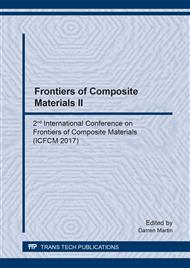[1]
F. Chen, B. Qiu, Y. Shangguan, Y. Song, Q. Zheng, Materials & Design 69 (2015) 56-63.
Google Scholar
[2]
S. Song, P. Wu, J. Feng, M. Ye, Y. Yang, Polymer 50 (2009) 286-295.
Google Scholar
[3]
C.-F. Ou, European Polymer Journal 38 (2002) 467-473.
Google Scholar
[4]
C. De Rosa, F. Auriemma, O. Tarallo, R. Di Girolamo, E. M. Troisi, S. Esposito, D. Liguori, F. Piemontasi, G. Vitale and G. Morini, Polymer Chemistry 8.4 (2017): 655-660.
DOI: 10.1039/c6py01950a
Google Scholar
[5]
Y. F. Zhang, D. Li and Q. J. Chen, Colloid and Polymer Science, 1-10 (2017).
Google Scholar
[6]
N.G.V. Fundador, Y. Enomoto-Rogers, A. Takemura, T. Iwata, Polymer Degradation and Stability 98 (2013) 1064-1071.
DOI: 10.1016/j.polymdegradstab.2013.01.010
Google Scholar
[7]
L. Guo, F. Chen, Y. Zhou, X. Liu, W. Xu, Composites Part B: Engineering 68 (2015) 300-309.
Google Scholar
[8]
M. Chalid, E. Yuanita, J. Pratama, Materials Science Forum, vol 827, 2015, pp.326-331.
Google Scholar
[9]
E. Yuanita, J.N. Pratama, J.H. Mustafa, M. Chalid, Procedia Chemistry 16 (2015) 608-615.
DOI: 10.1016/j.proche.2015.12.099
Google Scholar
[10]
J.N.P. Evana Yuanita, Mochamad Chalid, Macromolecular Symposia 371 (2017) 61-68.
Google Scholar
[11]
X. Jiang, S. Luo, K. Sun, X. Chen, Express Polymer Letters 1 (2007) 245-251.
Google Scholar
[12]
M. Avrami, The Journal of chemical physics 9 (1941) 177-184.
Google Scholar
[13]
S.M.L. Rosa, N. Rehman, M.I.G. de Miranda, S.M.B. Nachtigall, C.I.D. Bica, Carbohydrate Polymers 87 (2012) 1131-1138.
DOI: 10.1016/j.carbpol.2011.08.084
Google Scholar
[14]
C. Uma Maheswari, K. Obi Reddy, E. Muzenda, B.R. Guduri, A. Varada Rajulu, Biomass and Bioenergy 46 (2012) 555-563.
DOI: 10.1016/j.biombioe.2012.06.039
Google Scholar
[15]
H. Tibolla, F.M. Pelissari, F.C. Menegalli, LWT - Food Science and Technology 59 (2014) 1311-1318.
DOI: 10.1016/j.lwt.2014.04.011
Google Scholar
[16]
E. Abraham, B. Deepa, L.A. Pothen, J. Cintil, S. Thomas, M.J. John, R. Anandjiwala, S.S. Narine, Carbohydrate Polymers 92 (2013) 1477-1483.
DOI: 10.1016/j.carbpol.2012.10.056
Google Scholar
[17]
S. Reyes-de Vaaben, A. Aguilar, F. Avalos, L.F. Ramos-de Valle, Journal of Thermal Analysis and Calorimetry 93 (2008) 947.
DOI: 10.1007/s10973-007-8591-9
Google Scholar


